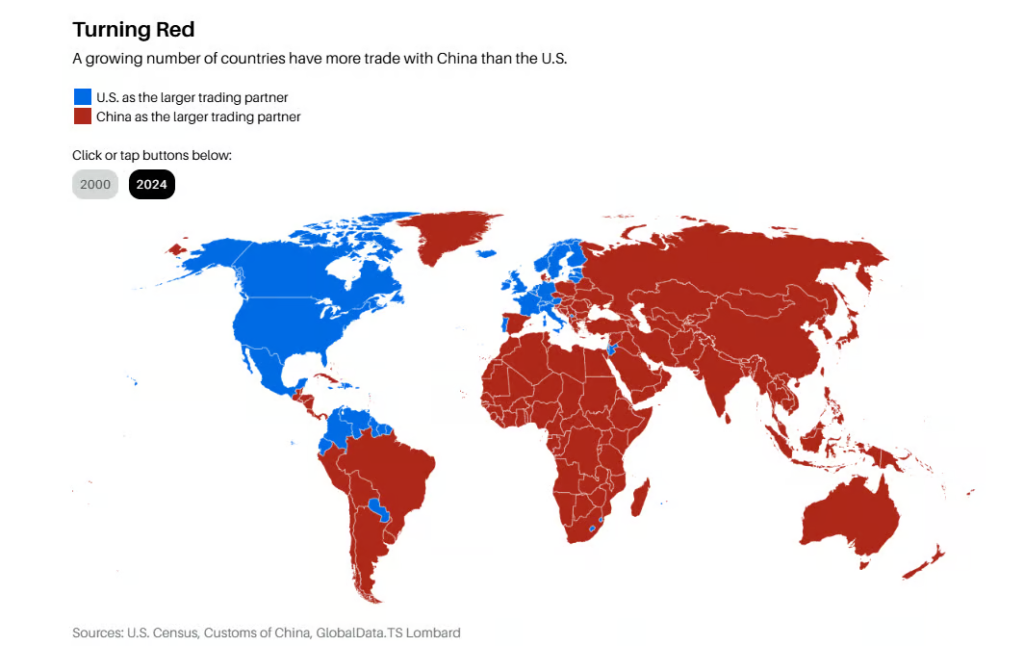1. S&P 500 Closes Below 200day

Stock Charts
2. The Percentage of Stocks Under 200day
Equities: The percentage of S&P 500 stocks trading above their 200-day moving average fell below 50% for the first time since 2023.

The Daily Shot
3. QQQ Closes Below 200day

Stock Charts
4. Semiconductor ETF—50day Closes Below 200day

Stock Charts
5. European Financials Straight Up 2025

Stock Charts
6. International Rally…Emerging Markets Have Not Broken Out Above Pre-Election Highs

Stock Charts
7. Gold/Platinum Indicator
MarketWatch Mark Hulbert-An obscure indicator with an excellent track record is forecasting a strong U.S. stock market over the next year.
This would be good news any time, but especially now with investors’ mood so pessimistic. Fear has grown so extreme in some pockets on Wall Street that some even are now arguing that contrarian analysis has stopped working.
The indicator to which I refer is the ratio of gold’s
According to a 2019 study, “Gold, Platinum and Expected Stock Returns,” the U.S. stock market more often than not rises over the subsequent 12 months when the gold/platinum ratio is in a strong uptrend — and vice versa. In fact, researchers Darien Huang, a former finance professor at Cornell University, and Mete Kilic, a finance professor at the University of Southern California, found that the ratio has a better track record than most of the other better-known indicators to which investors typically pay attention.
This is good news since the gold/platinum ratio has risen strongly over the last 12 months, as you can see from the chart above. The correlation between this ratio’s trailing 12-month change and the stock market’s subsequent 12-month change is significant at the 99% confidence level — higher even than the 95% level that statisticians often use when assessing whether a pattern is genuine.
The gold/platinum ratio has grown 25% over the past year, higher than 82% of all comparable readings of the past 20 years. As you can see from the table below, this puts the current ratio solidly in the quartile associated with impressive double-digit stock-market returns over the subsequent 12 months.

Market Watch
8. U.S./Canada/Mexico Trade $1.6 Trillion Per Year

Irrelevant Investor
9. 8 Million People Left Venezuela in Last 10 Years…82% Poverty Rate

Statista
10. Want to Keep Your Mind Sharp? Neurology Research Says Cutting Out This Food Can Improve Your Brain Function (and Make You Live Longer)
Not good news for meat lovers, but there is light at the end of the tunnel.
EXPERT OPINION BY MARCEL SCHWANTES, INC. CONTRIBUTING EDITOR, EXECUTIVE COACH, SPEAKER, AND AUTHOR @MARCELSCHWANTES
Imagine you’re gearing up for another high-stakes day—important meetings, big decisions, and lots of problem-solving. Your focus needs to be sharp and your mind clear; you want to be at the top of your game.
But what if one of the things you’re eating every day is quietly working against you?
Turns out, that giant burger at lunch or sizzling five strips of bacon in the morning might be doing more than adding to your waistline—it could be increasing your risk of dementia and even cutting your lifespan short.
The downside of too much processed meat
I’m not trying to be a Debbie Downer here, as I love a good, triple-decker turkey sandwich drenched in mustard. But consider the data: A massive study published in Neurologyfollowed over 133,000 health care professionals for more than four decades and found a clear connection between eating processed red meat—things like sausages, bacon, salami, and hot dogs—and a higher risk of cognitive decline.
People who ate about two servings of processed red meat per week had a 14 percent greater risk of developing dementia compared with those who ate it sparingly. And the rate of cognitive aging was even faster in regular consumers.
On the flip side, swapping out processed meats for plant-based proteins like nuts, beans, or tofu reduced dementia risk by 19 percent. It’s a small change with big benefits—not just for your brain at work, but for your longevity.
And it’s not just your mind at stake. The study estimated that if everyone ate less than 42g of red meat per day (less than half a serving), one in 10 deaths from heart disease and cancer could have been prevented.
But it’s not just about what you take out—it’s also about what you add in. Foods rich in “good fats,” like avocados, nuts, olive oil, and fatty fish, can help fight inflammation, protect your blood vessels, and support brain function. Your gut health also plays a massive role in cognitive performance. The latest research shows that eating more fiber-rich foods (like plants, beans, and fermented foods like kimchi) can improve gut health and lower your risk of mental decline.
Meanwhile, ultra-processed foods—like chips, sodas, and ready-made meals—have been linked to a 44 percent higher risk of dementia, according to another review of multiple studies. That’s a stat worth paying attention to next time you reach for a snack or drink from the vending machine.
The good news
So, do you need to cut out all meat forever? Not at all. Moderation is key. Ease up on red and processed meats and add more plant-based foods, good fats, and regular exercise. That’s the right balance. This lifestyle change won’t just help you live longer—it’ll help you think clearer, work smarter, and lead better. After all, a sharp mind and strong body are two of the best assets any entrepreneur or business leader can have.
The opinions expressed here by Inc.com columnists are their own, not those of Inc.com.








































